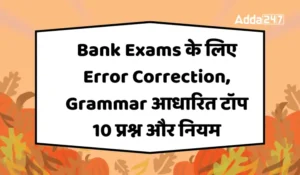Reading Comprehension for SBI PO Prelims (Week-04)
Directions (1-10): Read the following passage carefully and answer the questions given below them. Certain words/phrases have been printed in bold to help you locate them while answering some of the questions.
In March, the government announced that it would release an annual “state of nutrition” report, detailing India’s level of stunting, malnutrition and feature best practices for States to scale up nutrition interventions. It is clear that India has a lot to do to tackle nutrition challenges — 26 million children suffer from wasting (a low weight-for-height ratio), more than in any other country. Yet, the country has the second highest number of obese children in the world — 15.3 million in China and 14.4 million in India. While tackling undernutrition through assurance of adequate nutrition (usually interpreted as dietary calories), we need to ensure that it is also about appropriate nutrition (the right balance of nutrients). Our policy response has to move from “food security” to “nutrition security”.
India must step up its efforts to fight overweight and obesity just as it has been doing with wasting and stunting. Rising obesity is putting pressure on already fragile health systems in India by posing a high risk of chronic diseases such as cardiovascular diseases, diabetes and some cancers (clubbed together as non-communicable diseases, or NCDs). Research shows that Indians have higher levels of body fat and lower levels of lean muscle when compared to many other populations. Therefore, the risk of cardiovascular diseases and diabetes operates even below global thresholds for defining overweight and obesity. Hence the urgency to take public health measures. Apart from a high burden of premature mortality, these threats are something that India can ill-afford to ignore as it looks ambitiously toward a universal health coverage system where everyone can access quality health services that are free of financial burden.
The rise in obesity is deeply concerning because just as growing up underweight gives that person a lifetime of health problems so does a childhood of being overweight. The potent combination of Indian children eating more junk food while becoming increasingly sedentary puts them at an even greater risk. Research has shown that early warning signs for fatty liver disease can be found in children as young as eight if they had larger-than-advised waistlines when they were three. Fortunately, this year is an ideal opportunity to tackle obesity as global health decision-makers are focussing on how to garner the political will to drive “best buys” such as sugar taxes and mass media campaigns on healthy diets (proven ways of bringing down obesity) while continuing to vigorously pursue efforts to prevent undernutrition.
Policy responses should include agricultural systems that promote crop diversity (to enable dietary diversity) as well as regulatory and fiscal measures (to decrease the availability, affordability and promotion of unhealthy foods, while making healthy foods more accessible). For example, taking the lead from a directive by the Delhi High Court, India should ban the sale of junk food in and around schools. Legislators should also put into practice the results of a recent Lancet study on India. It showed that higher taxes on junk food can actually lead those on lower incomes to live healthier lives. Even in clinical settings, counselling and care are needed. Instead of being downgraded as ways of managing “poor lifestyle choices”, obesity management, prevention and treatment should be provided as essential health services targeted at a condition that undermines health in many ways. This would help reverse the stigma attached to obesity even by health professionals (which has also undermined the response to it).
Further, India should link obesity and undernutrition and treat them as twinned challenges to be jointly addressed under the universal health coverage umbrella. Universal health coverage is encapsulated in the idea that no one should have to suffer financial hardship in order to access essential health care. By tackling obesity through prevention and early care, financially debilitating NCDs can be avoided. India will be in a better position to fulfil the promise of universal health coverage if it disrupts the cycle whereby poverty leads to NCDs and vice versa. By making connections to both under- and over-nutrition, health advocates should make economic and social arguments to spur a ‘whole-of-government’ approach to these ‘whole-of-society’ problems. It is now time to get ahead of this unfolding health crisis and save lives and money in the process.
Q1. The passage is primarily concerned with which of the following?
(a) Decreasing children mortality rate
(b) Ways to prevent health issues in our country
(c) Methods to improve the conditions of malnutrition in India.
(d) Ways to improve conditions of non-communicable diseases.
(e) None of the Above
Sol. The passage covers various health issues like obesity, malnutrition etc and also throws light on what could be done to prevent these health issues in our country.
(a) proper availability of food.
(b) maintaining proper hygiene.
(c) the right balance of nutrients.
(d) making food affordable.
(e) None of the Above.
Sol. Refer 1st para last line.
(a) Malnutrition and child mortality
(b) Obesity and overweight
(c) Obesity and Undernutrition
(d) Undernutrition and child mortality
(e) None of the Above
Sol. Refer last para
(I) India has the second highest number of obese children in the world after China.
(II) Research shows that Indians have higher levels of body fat and lower levels of lean muscle when compared to many other populations.
(III) Universal health coverage is enveloped in the idea that no one should have to suffer financial hardship in order to access essential health care.
(a) Only (I)
(b) Only (II)
(c) Both (II) and (III)
(d) All are correct.
(e) None of the Above
Sol. Refer 1st and Ist para.
(a) Lower taxes on junk food can lead those on higher incomes to live healthier lives.
(b) Higher taxes on junk food can lead those on lower incomes to live healthier lives.
(c) Indians have higher levels of body fatls of and lower levels of lean muscle when compared to other populations.
(d) India is above China in number of obese children in world.
(e) None of the Above
Sol. Refer 4th para.
(a) Preventing non-communicable diseases.
(b) Addressing Universal health coverage.
(c) Politics and Health
(d) Preventing the next health crisis
(e) None of the Above
Sol. The most appropriate title for the passage is “Preventing the next health crisis”.
STUNT
(a) Encourage
(b) Foster
(c) Suppress
(d) Nurture
(e) Nourish
Sol. Stunt: to hinder the normal growth, development, or progress of
Suppress: prevent the development, action, or expression of (a feeling, impulse, idea, etc.); restrain.
Encourage: give support, confidence, or hope to (someone).
Foster: encourage the development of (something, especially something desirable).
Nurture: care for and protect (someone or something) while they are growing.
Nourish: provide with the food or other substances necessary for growth, health, and good condition.
FRAGILE
(a) Rigid
(b) Substantial
(c) Frail
(d) Resilient
(e) Supple
Sol. Fragile: easily destroyed or threatened.
Frail: easily damaged or broken; weak.
Rigid: not able to be changed or adapted.
Substantial: of considerable importance, size, or worth.
Resilient: of a person or animal) able to withstand or recover quickly from difficult conditions.
Supple: bending and moving easily and gracefully; flexible.
GARNER
(a) Amass
(b) Congregate
(c) Surrender
(d) Impede
(e) Disperse
Sol. Garner: gather or collect (something, especially information or approval).
Disperse: distribute or spread over a wide area.
Amass: gather together or accumulate (a large amount or number of material or things) over a period of time.
Congregate: gather into a crowd or mass.
Surrender: stop resisting to an enemy or opponent and submit to their authority.
Impede: delay or prevent (someone or something) by obstructing them; hinder.
SPUR
(a) Countenance
(b) Goad
(c) Dissuade
(d) Propel
(e) Prod
Sol. Spur: a thing that prompts or encourages someone; an incentive.
Dissuade: persuade (someone) not to take a particular course of action.
Countenance: support or approval.
Goad: provoke or annoy (someone) so as to stimulate an action or reaction
Propel: drive or push something forwards.
Prod: stimulate or persuade (someone who is reluctant or slow) to do something.
Q11. It is also a tale that began 100 (A)/days before the firing, when(B)/ housewives, children and villagers(C)/ creating a community of protest which found its(D)/ one-lakh-strong epicentre at Thoothukudi(E).
(a) B
(b) C
(c) A
(d) D
(e) No error
Sol. As the sentence is in past tense, ‘created’ should be used in place of ‘creating’.
(a) B
(b) C
(c) A
(d) D
(e) No error
Sol. Replace ‘faint’ with ‘fainting’.
(a) B
(b) C
(c) A
(d) D
(e) No error
Sol. Replace ‘requested’ by ‘request’.
(a) B
(b) C
(c) A
(d) D
(e) No error
Sol. The sentence is grammatically Correct.
(a) B
(b) C
(c) A
(d) D
(e) No error
Sol. The sentence is grammatically correct.






 Practice for English Section: 15 Cloze T...
Practice for English Section: 15 Cloze T...
 Bank Exams के लिए Error Correction, Gram...
Bank Exams के लिए Error Correction, Gram...
 English Quiz For NIACL AO Mains 2024 Exa...
English Quiz For NIACL AO Mains 2024 Exa...








